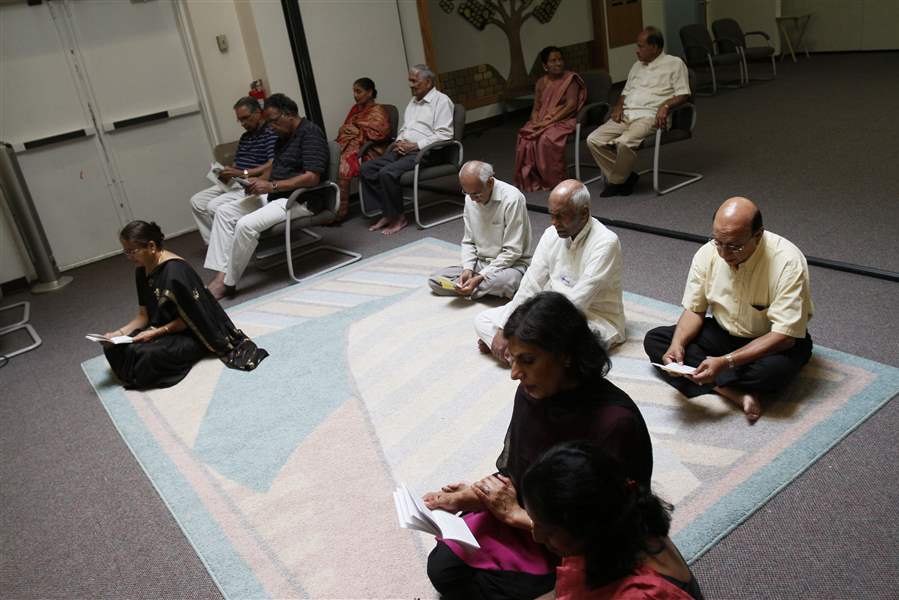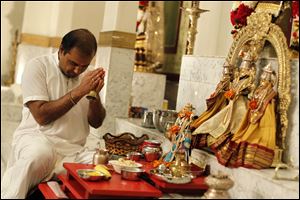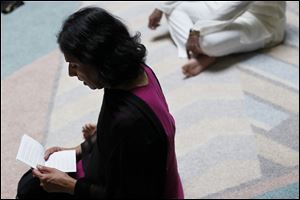
Asian groups organize to keep cultures alive
Special schools foster traditions
9/3/2012
Members pray during worship at the Hindu Temple in Sylvania Township. Ground for the site was broken in 1986, and the temple was completed in 1989.
ZACK CONKLE/THE BLADE
Buy This Image

Pandit Anantkumar B. Dixit prays with his congregation at the Hindu Temple in Toledo, formed in the early 1980s.
Second of three parts
As Pandit Anantkumar Dixit sang the prayer and recited shloka in Sanskrit, more than 50 Hindu worshipers sat solemnly before him.
That spiritual moment of puja, the weekly worship, takes place every Sunday at noon in the Hindu Temple and Heritage Hall of Toledo.
At the end of the puja, worshipers lined up to sing aarti, a form of prayer.
Dressed in traditional costumes, little children climbed onto the shoulders of their parents, trying to reach the bells, ghanta, as a part of the puja ritual.
RELATED ARTICLES:
Day 2
Day 1
Although most of them were born and raised in Toledo, these children managed to keep the Hindu tradition through close contact with the Indian-American community at the temple.
Since the mid-1960s, the Asian-American population in the United States has grown because of more welcoming immigration policies.
But compared with their counterparts in coastal cities, Asian-Americans in Toledo have been more scattered, with a slower pace of growth.
Such characteristics have brought pros and cons.
Although integrating became easier for Asian-Americans in Toledo, building strong communities among themselves was a challenge.
In June, the Pew Research Center published a 215-page report, "The Rise of Asian-Americans," based on its telephone survey of a nationally representative sample of 3,511 Asian-Americans.
"Many immigrants must balance the need to adapt to the language and culture of the U.S. with their desire to maintain ties to their native country," the report states.
"When I got here in 1974, there were only a handful of Indian families in Toledo," said Ajit Jaggi, chairman of the Hindu Temple.
One of the first Indian-Americans in Toledo, Mr. Jaggi came directly from India as an engineer.
Today almost all Asian-American communities have formed their own organizations, many of which were built by immigrants who arrived in the 1960s and 1970s. These cultural and religious groups provide bonding opportunities for longtime residents as well as newcomers.
"Originally, we wanted to build something like an Indian Cultural Center, which would be secular, but we also needed a religious space too," Mr. Jaggi said. "So we started to ask for donations to build the temple."
A few Indian-Americans, including Mr. Jaggi, then committed to building a religious and cultural space for their community. The organization "Hindu Temple of Toledo" was born on Dec. 3, 1981.
Thanks to their efforts, the organization acquired 15 acres of land on King Road in Sylvania Township in 1983. But because the group lacked sufficient funding, some of its founding members contributed personally to buy the land.
This was only the first step.
In 1986, founding members started a door-to-door fund-raising campaign to build the temple.
Before the temple was built, the congregation met in a small building for the puja worship.
Slowly, the idea of building a Hindu temple in the area "got into people's mind," Mr. Jaggi said.
The organization collected more than $400,000 to start construction.
On Oct. 12, 1986, ground was broken on Dussera, one of the holiest days in the Hindu calendar, honoring the victory of good over evil.
The temple was completed in 1989.

Members pray during worship at the Hindu Temple in Sylvania Township. Ground for the site was broken in 1986, and the temple was completed in 1989.
Ongoing expansion
Since then, it has continued to expand.
Today the space includes a temple area, or mandir in Hindi, and a heritage hall, where more than 100 Indian-American families have lunch together after Sunday services.
"This temple belongs to everyone who celebrates the Hindu tradition and Indian culture," Mr. Jaggi said.
Similar to the Indian-Americans, the Chinese-American community faced significant challenges in building their association.
"The Chinese Association of Greater Toledo was first founded in 1965. But there were only a dozen members, and they were not very active," said Jiquan Chen, the association's president and a professor at the University of Toledo.
As Mr. Chen reflected on the association's history, he pointed to a photo album from 1979.
In the photos, the association's members were in traditional Chinese costumes.
However, behind the smiling faces and colorful costumes were empty walls.
"You can clearly see that the event was hosted at someone's house, and they could only present their traditional costumes and have their gathering at home.
"Today even my family can host a party with more people than an association did in the '70s," Mr. Chen said.
In one of the old photos, members of the association were selling egg rolls at an international festival, as a fund-raiser.
"We had almost $1,000 left from the '70s. The money came from various fund-raising activities, such as selling egg rolls," Mr. Chen said. "Imagine how much an egg roll cost in 1970s."
But funding was not the only issue. Although the association claimed to be a nonprofit organization, it was not properly registered with the Internal Revenue Service, according to Mr. Chen.
"Things were not systematic and formalized," Mr. Chen said. "It took two years to get the association back on track, such as writing bylaws and setting up the board."

Jayashree Kunnathur reads a prayer during a worship service at the Hindu Temple and Heritage Hall.
100 families
Today the Chinese Association has more than 100 families as registered members.
The association organizes events on important Chinese festivals, and members gather often for activities such as the weekly Saturday tai chi practice in Wildwood Preserve Metropark.
But community building was only one of the many challenges for Toledo's first generation of Asian-Americans.
For many Asian immigrant parents, once they settled in Toledo, the next urgent task was to foster an environment for their children to learn their cultural heritage.
According to the Pew Research Center's report, 80 percent of Asian-Americans say it is at least somewhat important to them that their descendants can speak their native or ancestral language.
In Toledo, four Asian-American communities -- Chinese, Korean, Japanese, and Indian -- have established their own schools that provide weekend classes for children to learn about their cultural heritage and language.
The Hindu temple has been host to the Hindu Sunday school since 2005.
Started by a group of professors and engineers, the Hindu Sunday school is rare for its combination of religious and secular education.
"I came to Toledo to teach physics at University of Toledo. At the time, I had a son [who was] about 3 years old, and I needed to teach him Hinduism. Then our priest suggested to start something like a school at the temple for all the families," said Sanjay V. Khare, a founder of the Hindu school.
"We focus on teaching how to practice Hinduism in day-to-day life," Mr. Khare said.
The class session is divided into various parts, which include the basic theories of Hinduism, listening to mythical stories, and reading shloka, the basis of Indian epic verse.
The majority of students are children ages 4 to 14.
In the last two years, the school has added a more advanced session for youths between 14 and 18 years old.
"We encourage them to ask questions. In the beginning, children have lots of confusion, so we want them to talk about how they feel," said Ravi Josh, a teacher at the temple's Sunday school and an engineer at Bendix LLC.
"I am happy that the school can give the kids structure [to learn about Hinduism]. They grow up in Western culture, so they need a classroom setting."
Rice experiment
Like the Hindu Sunday school, other Asian cultural and language schools have tried to explore engaging teaching methods in their curriculum.
Yong Jin Kang, the principal of the Korean School, said that she once asked her students to cook different kinds of rice and compare them.
"Korean kids tend to think that our rice is the best. But through that class session, they got to know that other cultures had their own ways of cooking rice. … I always try to compare Korean culture with American culture. I try to emphasize the things in common in different cultures. It is not like one is better than the other." Mrs. Kang said.
Mrs. Kang, who holds a PhD in education, was recently elected president of the National Association for Korean Schools.
"It is a lot of work for the children and the parents because they are giving up a big chunk of their time. The kids vaguely understand, but sometimes they would ask why they had to come here. You know, they could have spent that time playing video games," Mrs. Kang said.
Indeed, going to language and cultural schools requires devotion and persistence from parents, children, and volunteer teachers.
Mr. Khare said that getting more volunteer teachers involved is a major challenge for the school.
"It means that you can't leave Toledo and go somewhere else for a weekend during the semester. … But the outcome of attending the school is not something that you see in a day or a month. It is not very tangible. But kids who do come regularly often become leaders when they grow up," Mr. Khare said.
"When the kids grow up, they know better how to function between the Asian and Western cultures," Mr. Josh added.
In the past five decades, the first generation of Asian-American immigrants has overcome challenges to settle in and build their communities in Toledo. Keeping a delicate balance between the American way of life and the Asian heritage, the second and third generations of Asian-Americans in Toledo have thrived.
"In a globalized age, maintaining the Asian heritage and language is an asset for both Asian-Americans and for the country," Mrs. Kang said.
Liyan Chen, a graduate of Grinnell College, was a summer intern for The Blade. A native of China, she now attends graduate school at New York University.